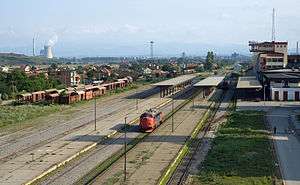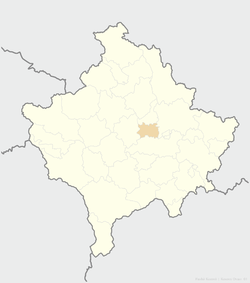Kosovo Polje
| Fushë Kosovë Kosovo Polje | |
|---|---|
| Town and municipality | |
|
Albanian: Fushë Kosovë / Fushë Kosova Serbian: Косово Поље/ Kosovo Polje | |
 Railway station, March 2010 | |
 Location of the municipality of Kosovo Polje within Kosovo | |
| Coordinates: 42°38′N 21°5′E / 42.633°N 21.083°E | |
| Country | Kosovo[lower-alpha 1] |
| District | District of Pristina |
| Villages | 18 |
| Government | |
| • Mayor | Burim Berisha |
| • Municipal | 83 km2 (32 sq mi) |
| Elevation | 543 m (1,781 ft) |
| Population (2011) | |
| • Urban | 12,919 |
| • Municipal | 33,997 |
| • Municipal density | 410/km2 (1,100/sq mi) |
| Time zone | UTC+1 (CET) |
| • Summer (DST) | UTC+2 (CEST) |
| Postal code | 12000 |
| Area code(s) | +383 38 |
| Car plates | 01 |
| Website |
kk |
Kosovo Polje (Serbian: Косово Поље, "Kosovo Field") or Fushë Kosovë (Albanian: Fushë Kosova) is a town and municipality located in the Pristina district in central of Kosovo.[lower-alpha 1] According to the 2011 census, the town of Kosovo Polje has 12,919 inhabitants, while the municipality has 33,977 inhabitants.
Geography
The town is located in central Kosovo, some 8 kilometers (5.0 mi) southwest of Pristina, the capital of Kosovo. It is served by the Fushë Kosovë railway station.
History
Kosovo Polje was named after the Kosovo Field of the 1389 Battle of Kosovo. The settlement of Kosovo Polje was established in 1921 during the Kingdom of Yugoslavia (see Colonisation of Kosovo).[1]
Prior to the 1999 Kosovo War, the town of Kosovo Polje had, according to the figures of the Federal Statistical Office in Belgrade from March 1991, a total population of 35,570 inhabitants, while the ethnic makeup was 56.6% Albanian, 23.7% Serb and 19.6% from other communities.[2]
Kosovo Polje saw considerable violence before, during and after the Kosovo War. In December 1998, Serbian deputy mayor of Kosovo Polje Zvonko Bojanić was executed by members of the Kosovo Liberation Army, despite taking a moderate line on Serb-Albanian relations.[3] At the war's end in June 1999, most of the Albanian population returned while many of the town's Serbs were expelled. The remaining Serb population found themselves in an enclave in an Albanian-dominated region. Thousands of Serbs and Roma from other parts of Kosovo, who had fled their homes, took refuge in Kosovo Polje, where a large refugee camp was established.[4] Ethnic tension flared repeatedly in the years after the war and a number of Serbs were killed by Albanian nationalists. Under this continuing pressure, the Serb population of Kosovo Polje shrank steadily until, by July 2002, the newspaper Blic was reporting that only 550 Serbs remained in Kosovo Polje. The town was seriously affected by the March 2004 unrest in Kosovo, which saw almost all Serb inhabitants expelled and their homes burned down.[5] A number are reported to have returned since then and at least some of the destroyed properties have been rebuilt by UNMIK.
Economy
There are two magnesium mines operating on the territory of Kosovo Polje: Goleš and Strezovce.
Demographics
| Municipal historical population | ||
|---|---|---|
| Year | Pop. | ±% p.a. |
| 1948 | 8,041 | — |
| 1953 | 9,288 | +2.93% |
| 1961 | 12,286 | +3.56% |
| 1971 | 20,889 | +5.45% |
| 1981 | 29,805 | +3.62% |
| 1991 | 35,570 | +1.78% |
| 2011 | 34,827 | −0.11% |
| 2016 est. | 37,048 | +1.24% |
| Source: Division of Kosovo | ||
According to the last official census done in 2011, the municipality of Kosovo Polje has 34,827 inhabitants.
Ethnic groups
The ethnic composition of the municipality:
| Ethnic Composition, Including IDPs | |||||||||||
|---|---|---|---|---|---|---|---|---|---|---|---|
| Year | Albanians | % | Serbs | % | Ashkali | % | Roma | % | Other | % | Total |
| 1991[6] | 20,142 | 56.6 | 8,445 | 23.7 | 6,983 | 19.6 | 35,570 | ||||
| 1998 | 23,600 | 59 | 9,600 | 24 | 40,000 | ||||||
| June 2000 | 34,000 | 84 | 4,000 | 10 | 2,600 | 6.4 | 300 | 0.7 | 60 | 0.14 | 40,500 |
| April 2002[7] | 34,000 | 85 | 3,239 | 8 | 2,259 | 5.6 | 388 | 1 | 21 | 0.05 | 40,000 |
| 2011[8] | 30,275 | 86.9 | 321 | 0.9 | 3,230 | 9.3 | 436 | 1,3 | 565 | 1.6 | 34,827 |
Annotations
- 1 2 Kosovo is the subject of a territorial dispute between the Republic of Kosovo and the Republic of Serbia. The Republic of Kosovo unilaterally declared independence on 17 February 2008, but Serbia continues to claim it as part of its own sovereign territory. The two governments began to normalise relations in 2013, as part of the Brussels Agreement. Kosovo has received formal recognition as an independent state from 113 out of 193 United Nations member states.
References
- ↑ Pavlović, Aleksandar. "Prostorni raspored Srba i Crnogoraca kolonizovanih na Kosovo i Metohiju u periodu između 1918. i 1941. godine" (PDF). Archived from the original (PDF) on 2011-08-26.
- ↑ Brunborg, Helge (14 August 2002). "Report on the size and ethnic composition of the population of Kosovo", p. 9. Retrieved February 9, 2015.
- ↑ Tim Judah (2002). Kosovo: War and Revenge. Yale University Press. p. 192. ISBN 978-0-30009-725-2.
- ↑ Peter Bouckaert (2004). Failure to Protect: Anti-minority Violence in Kosovo, March 2004, 16 (6). Human Rights Watch. p. 42.
- ↑ Peter Bouckaert (2004). Failure to Protect: Anti-minority Violence in Kosovo, March 2004. 16. Human Rights Watch. pp. 42–43.
- ↑ Brunborg, Helge (14 August 2002). "Report on the size and ethnic composition of the population of Kosovo" (PDF). p. 9. Retrieved 28 December 2014.
- ↑ OSCE (April 2002). "OSCE municipal profile of Fushë Kosovë/Kosovo Polje - April 2002". OSCE. Archived from the original on 2011-06-06.
- ↑ "FUSHË KOSOVË/KOSOVO POLJE MUNICIPAL PROFILE March 2014". OSCE Mission in Kosovo. March 2014. p. 1. Retrieved 28 December 2014.
External links
![]()
